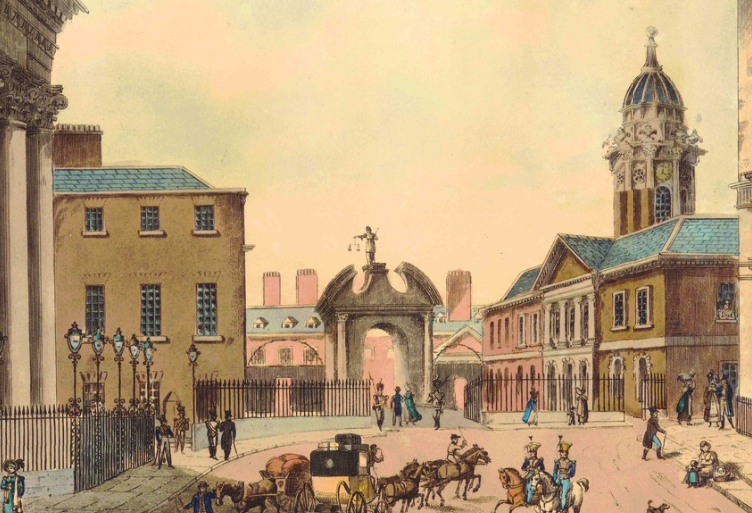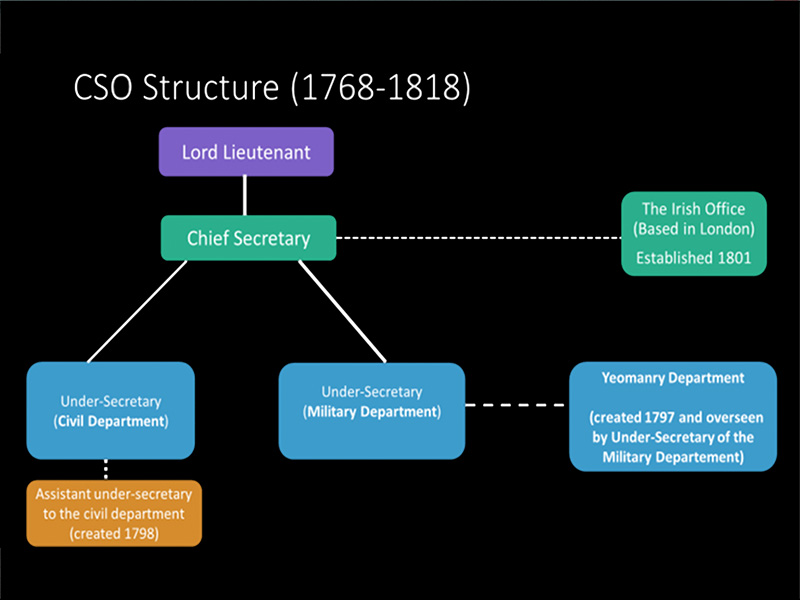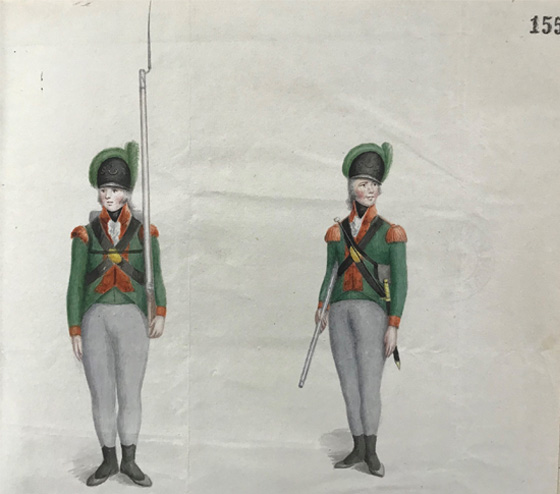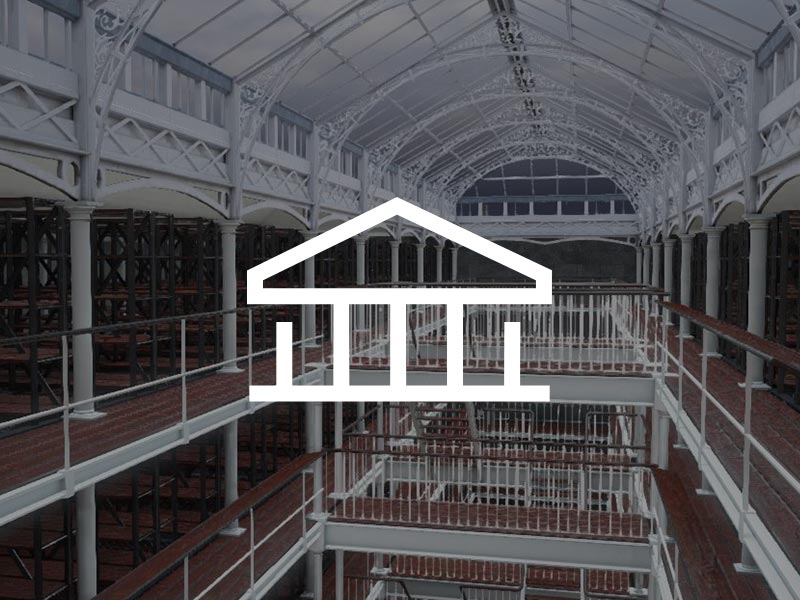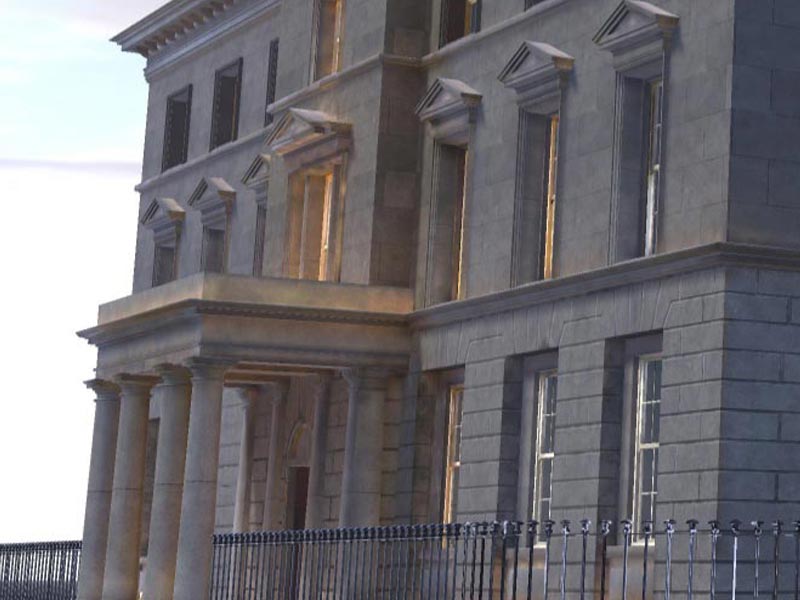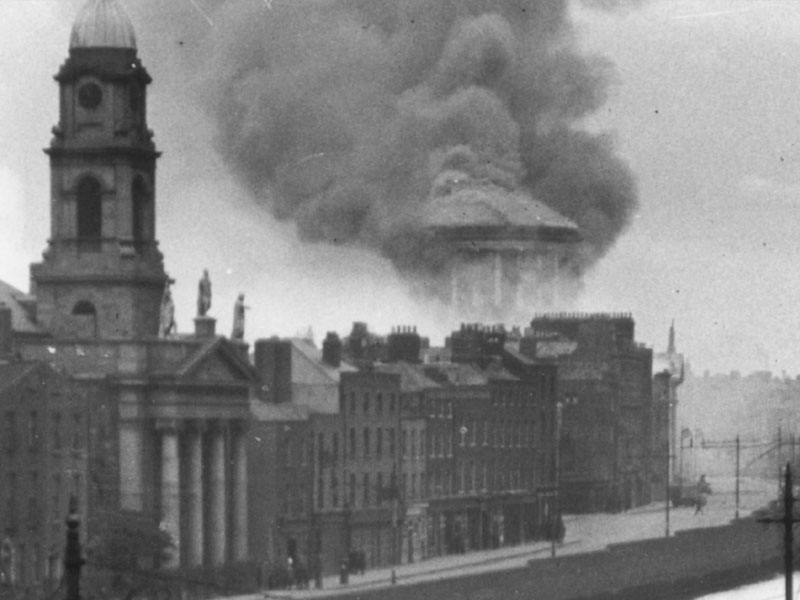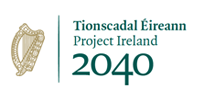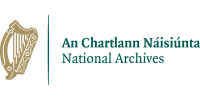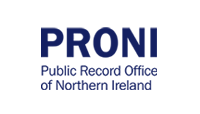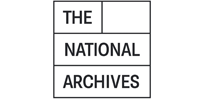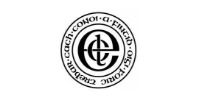
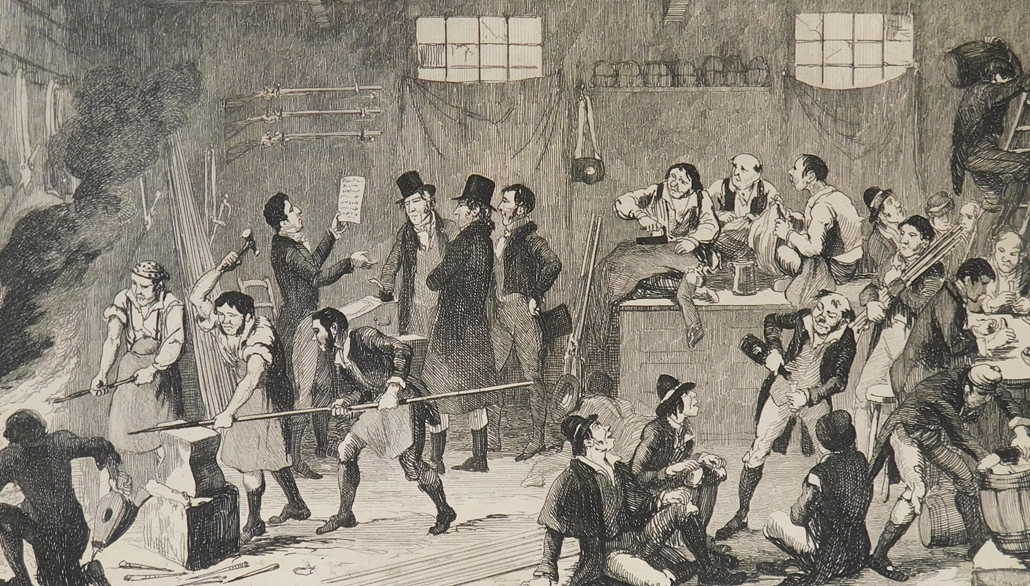
The Home Office and Ireland (1793–1803) – Delving Deeper
The content of HO 100 is extremely varied, even compared to other Home Office series. This is due to the wide remit of both bodies that created the series, the Home Office and the Irish Chief Secretary’s Office (CSO).
The content of the letters
The content of HO 100 is extremely varied, even compared to other Home Office series. This is due to the wide remit of both bodies that created the series, the Home Office and the Irish Chief Secretary’s Office (CSO). The Home Office was entrusted with overseeing all domestic affairs that did not specifically come under another department’s purview. The result was that the Home Office has acquired a reputation among historians as an administrative ‘waste-paper basket’, due to the wide range of functions it oversaw. In Dublin, the CSO had evolved by the 1780s to become the main supervising agency within Ireland’s central government, and has been described as having many of the functions of the Home Office. As a result of this, HO 100 contains letters that touch on almost every aspect of public life.
The majority of the items are letters between senior figures in their respective office, such as the correspondence between the Lord Lieutenant in Dublin and the Home Secretary in London. While it is mostly the letters written by the Lord Lieutenant, some copies of the Home Secretary’s replies have been preserved and are included. Similarly, there are a large number of letters from the Irish Chief Secretary to his opposite number in the Home Office, the parliamentary under-secretary. Other officials in Dublin Castle, such as the civil and military under-secretaries, are also frequent correspondents to the Home Office. However, in addition to these letters, Dublin Castle frequently sent copies or extracts of letters that it had received from various correspondents in Ireland. This included figures like the Irish Attorney-General or the Irish Chancellor, but also minor officials like customs inspectors, county magistrates and even paid informants. In some cases, the Irish government transmitted reports or digests of information it had received on key topics.
The volumes in the current sample are divided into two categories: civil correspondence and military correspondence. In addition, there are a few volumes labelled ‘Private, Secret and Confidential’, or sometimes ‘Private and Miscellaneous’. These volumes mainly related to civil matters, although the contents of which are usually more informal in nature than the correspondence in ‘civil’ volumes. While the contents of these volumes are incredibly varied, some common topics are listed below.
Civil correspondence:
- Law and Order, including reports of disturbances, as well as letters relating to policing, prisons and transportation.
- Intelligence regarding possible conspiracies against the state. Often included are radical publications or extracts from informers’ reports.
- Irish parliamentary matters, including accounts of parliamentary sessions. Frequently includes lists of bills to receive assent.
- Promotions in the Irish peerage, in the hierarchy of the Church of Ireland, and nominations to the Irish Privy Council.
- Legal opinions of Irish law officers, appointments to the judiciary, and reports on notable state prosecutions.
- Memorials and petitions to the government. These range from loyal addresses to the King, to those seeking patents for inventions, or requesting new legislation.
Military correspondence:
- Embarkation and disembarkation returns, these show the date and place of regiments either arriving or leaving Ireland.
- Disciplinary matters, such as lists of officers absent without leave, and reports of court martials.
- Lists of successions in the army, detailing promotions within regiments.
- Returns of the army and militia, providing numbers of troops in the country on a specified date.
- Reports on the state of military districts, these are most common after 1797.
- Recruitment and proposals for new regiments.
The Home Office: Foundation and Functions
The Home Office was created in the immediate aftermath of Britain’s loss of its American colonies. The fall-out of the American Revolutionary war brought scrutiny of Britain’s archaic and often expensive systems of administration, with calls for ‘economical reform’. As a result, the existing division of ministerial duties was altered. Prior to 1782, the primary division among British Secretaries of State was between the Northern and Southern Department. The Southern Department was responsible for Ireland, along with Wales, the south of England, and the Catholic states of Europe. The Northern Department was responsible for northern England, Scotland, and the Protestant states of Europe. This confusing and inconvenient division was discontinued in 1782, with the introduction of a new division between the Home and Foreign Departments. The newly-formed Home Office assumed a broad range of responsibilities concerning domestic affairs, including Ireland.
The American War had also had a profound impact on Irish politics, ushering in the era of ‘Grattan’s Parliament’, as Westminster was pressured into renouncing its right to legislate for Ireland in 1782. This was termed “legislative independence” by some Irish MPs, and London lost several methods for controlling Irish legislation. However, the Irish executive, based in Dublin Castle and composed of the Lord Lieutenant and the staff of his
Chief Secretary’s Office, still had command of substantial government patronage. This allowed it to exert significant influence over the Irish parliament, bolstering the political role of the Lord Lieutenant and his Chief Secretary. Thus, when it came to Ireland, the correspondence between the Chief Secretary and the Home Office was of vital importance. The primary aim of the Home Office with regards to Ireland, was to ensure that the Irish parliament made decisions that suited British requirements. These included: a ready supply of troops; Irish trade policies which did not conflict with those of Britain; and an Ireland that could resist a foreign invasion.
Events in Ireland often produced a close and frequent correspondence between the Home Office and the Chief Secretary’s Office. The letters in HO 100 illustrate how Dublin and London officials coordinated their response to a multitude of threats. During the years 1782–1800, the country witnessed several contentious political campaigns, both for parliamentary reform and for Catholic rights. The outbreak of the French Revolutionary War in 1793 also brought the threat of foreign invasion, with several attempted landings by the French navy, such as that at Bantry Bay in late 1796. The result was an enhanced level of cooperation and intelligence-sharing between Dublin Castle and the Home Office, as each sought to eliminate the threat posed by Irish revolutionary conspiracy, as personified in the Society of United Irishmen, Ireland’s first explicitly republican separatist movement.
The culmination of the United Irishmen’s planning was a bloody rebellion in 1798, which killed at least 10,000 people in a single summer of fighting. In reaction, the British government instituted the Act of Union, which abolished the Irish Parliament and merged Ireland into the United Kingdom. At the time, some had assumed that this would also involve a diminished role for the Irish Chief Secretary, with Ireland being governed directly via the Home Office. This situation did not come to pass, with a significant bureaucracy retained in Dublin Castle, overseen by the Chief Secretary’s Office. The persistent issue of Catholic political rights, including the rise of Daniel O’Connell as leader of the Irish Catholic nation, ensured that the Irish Chief Secretary’s Office was kept busy during the 1820s and 1830s.
Archival history
HO 100 is the product of the Home Office’s internal filing system, itself highly similar to that of its precursor organization, the Southern Department. HO 100 contains letters written by the Lord Lieutenant directly to the Home Secretary, as well as between the Irish Chief Secretary and the parliamentary under-secretary in the Home Office. All dispatches from Dublin Castle — other than letters relating to finance — were sent to the Home Office. Financial business went directly to the Treasury, and is therefore largely absent from HO 100.
When letters from Ireland reached the Home Office, they would have been opened by Home Office clerks and prepared for review. The Home Secretary was assisted by his two under-secretaries: the parliamentary under-secretary (who changed with the Home Secretary when his tenure was over), and the permanent under-secretary (who was not an MP and thus not affected by changes of government). These under-secretaries oversaw the sorting of all the correspondence received by the Home Office, dividing responsibilities between them. Letters concerning Ireland were allocated to the parliamentary under-secretary, as there was no separate office or clerk designated specifically for dealing with Irish affairs.
The Home Secretary and his under-secretaries attended daily meetings to discuss replies and any additional actions required, such as consulting crown law officers. Many letters were of a basic administrative nature, and these only required an acknowledgment of receipt of a very simple response, and were thus dealt with by the under-secretaries or their clerks. For instance, certain military functions, like commissioning of officers, required a great deal of routine paperwork. Letters which required the attention of the secretary of state, for example correspondence of a delicate political nature, were set aside for the Home Secretary.
In certain instances, items received by the Home Office were ‘docketed’. This was a procedure in which, once a response was agreed upon, a corner of the original letter was turned down and the following information was noted on the item: the author’s name, the date it was sent, the date of reply, and a note of its contents on the reverse of the letter. While these are relatively rare within the HO 100 series, they do occasionally provide some insight into the internal procedures of the Home Office. Unlike other series of Home Office material, it seems that dispatches to Ireland were not entered into dedicated letter books, but copies of official responses were made on loose folio sheets and are now bound with the in-letters that constitute the volumes of HO 100.
System of arrangement
The contents of this series span the years 1782 to 1851, and are contained in 264 bound volumes. Each volume consists, for the most part, of letters from Dublin Castle to the Home Office. However, copies of London’s reply were frequently made on loose folio sheets, which are now bound alongside the in-letters. These volumes are ordered chronologically.
Between 1782 and 1811, the volumes are explicitly divided into three categories:
- Civil
- Military
- Miscellaneous
There is also a run of volumes between 1796 and 1809 which are labeled ‘Private and Secret’, and which mainly relate to civil matters, although the contents of which are usually more informal in nature than the correspondence in ‘civil’ volumes.
Between 1812 and 1838, the arrangement altered slightly. Due to the decline of military matters under the supervision of the Chief Secretary’s Office, military and civil affairs are arranged together in volumes labeled simply
‘Letters and Papers’. The material is still grouped by year and arranged chronologically within volumes. Volumes of ‘miscellaneous’ correspondence continued up until 1838.
There are several volumes labeled ‘Reports of outrages’, which take the form of dated summaries of information received by Dublin Castle of disturbances. Dedicated ‘outrage’ volumes exist for the years 1829 and 1837–1840, although reports and letters involving outrages are also scattered throughout the volumes labeled ‘Letters and Papers’ for the years 1830-36. Material relating to the Irish Poor Law and its implantation can be found in three volumes, dating from 1836–9.
In addition, there are several single volumes which relate to specific topics, such as ‘Papers relating to Roman Catholics in Ireland, 1800–4’, ‘Peerage Claims, 1828–31’ and ‘Catholic Emancipation, 1824’.
Methodology and Scope
In order to make the contents of the HO 100 series more accessible, we have constructed a selective calendar of some of its contents. This work was made possible by the generous support of The Friends of The National Archives. This calendaring involved creating descriptions, and in some cases transcriptions, of a selection of items from within the series. It should be noted that HO 100 is a large series, covering the years 1782 to 1840. It consists of 264 volumes of material, each volume containing between 200 and 300 letters, making a full calendaring of the entire series beyond the scope of the current project. Instead, we have chosen to pursue a selective calendaring of a sample of 80 volumes, representing about 30 % of the overall series. The volumes selected cover the decade between 1793 and 1803.
We have chosen these dates because this decade was a particularly significant one in Irish and British history, encompassing the Revolutionary and Napoleonic Wars, the birth of Irish republicanism, the 1798 Rebellion, the Act of Union, and Robert Emmet’s insurrection of 1803. Surveying the relevant volumes of HO 100 for these years, we have selected between 10 to 20 items per volume, providing description and often partial or full transcription. The items chosen for this ‘selective calendaring’ have been picked according to several criteria. First, we have attempted to include items that illuminate significant historical events or developments, such as the 1798 Rebellion or the Act of Union. We have also sought to include letters which shed light on the social history of the period, including how regular men and women experienced the significant events occurring around them. The second criteria was that items should be representative of the larger series, giving users a sense of what type of correspondence are contained in these volumes, and what sort of subject matter you can typically find within these letters. While these choices are subjective, we hope they will convey a sense of the possibilities that HO 100 offers to prospective researchers.
Key figures within the series
The following is a list of individuals who recur in the present selection from the HO 100 series, relating to the years 1793 to 1803. The list is divided by organization and office, with the dates the individual held each office included after their name. Hyperlinks direct you to published lives in the Dictionary of Irish Biography and relevant data within the Knowledge Graph for Irish History.
The Home Office (London)
Home Secretary
Henry Dundas, 1791–1794
William Cavendish-Bentick, 3rd Duke of Portland, 1794–1801 (view DIB; view Knowledge Graph)
Thomas Pelham, 1801–1803 (view DIB; view Knowledge Graph)
Parliamentary Under-Secretary
Scrope Bernard, 1789–1794
Thomas Brodrick, 1794–1796
Charles Grenville, 1796–1798
William Wickham, 1798–1801 (view DIB; view Knowledge Graph)
Edward Finch Hatton, 1801
Sir George Shee, 1801–1803 (view DIB)
Permanent Under-Secretary
Evan Nepean, 1782–1791
John King, 1791–1806
Superintendent of Aliens
William Huskisson, 1793–1794
William Wickham, 1794–1795, 1798–1801 (view DIB; view Knowledge Graph)
Charles William Flint, 1801–1803
The Chief Secretary’s Office (Dublin)
Lord Lieutenant
Earl of Westmorland, 1789–1794 (view DIB; view Knowledge Graph)
Earl Fitzwilliam, 1795 (view DIB)
Earl Camden, 1795–1798 (view DIB)
Marquess Cornwallis, 1798–1801 (view DIB)
Earl of Hardwicke, 1801–1805 (view DIB; view Knowledge Graph)
Chief Secretary
Sylvester Douglas, 1793–1794
Thomas Pelham, 1795–1798 (view DIB; view Knowledge Graph)
Viscount Castlereagh, 1798–1801 (view DIB; view Knowledge Graph)
Charles Abbot, 1801 (view DIB; view Knowledge Graph)
William Wickham, 1802–1804 (view DIB; view Knowledge Graph)
Under-Secretaries
Sackville Hamilton, civil under-secretary 1780–1796 (view DIB)
Edward Cooke, military under-secretary 1789–1795, civil under-secretary 1796–1801 (view DIB)
Alexander Marsden, civil under-secretary 1801–1806 (view DIB)
William Elliot, military under-secretary 1796–1801 (view DIB)
Edward Littlehales, military under-secretary 1801–1819
Further Reading
R.R. Nelson, The Home Office, 1782–1801 (Durham, 1969).
R.B. McDowell, The Irish Administration, 1801–1914 (Routledge,1964).
K.T. Hoppen, Governing Hibernia: British Politicians and Ireland, 1800–1921 (Oxford, 2016).
Nathan Ashely Bend, ‘The Home Office and Public Disturbance, c.1800–1832’ (PhD thesis, University of Hertfordshire, 2018).
